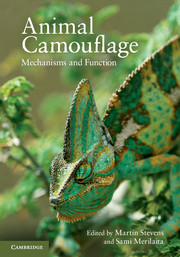Book contents
- Frontmatter
- Contents
- Contributors
- 1 Animal camouflage
- 2 Crypsis through background matching
- 3 The concealment of body parts through coincident disruptive coloration
- 4 The history, theory and evidence for a cryptic function of countershading
- 5 Camouflage-breaking mathematical operators and countershading
- 6 Nature's artistry
- 7 Camouflage behaviour and body orientation on backgrounds containing directional patterns
- 8 Camouflage and visual perception
- 9 Rapid adaptive camouflage in cephalopods
- 10 What can camouflage tell us about non-human visual perception? A case study of multiple cue use in cuttlefish (Sepia spp.)
- 11 Camouflage in marine fish
- 12 Camouflage in decorator crabs
- 13 Camouflage in colour-changing animals
- 14 The multiple disguises of spiders
- 15 Effects of animal camouflage on the evolution of live backgrounds
- 16 The functions of black-and-white coloration in mammals
- 17 Evidence for camouflage involving senses other than vision
- Index
- Plate section
- References
9 - Rapid adaptive camouflage in cephalopods
Published online by Cambridge University Press: 05 June 2012
- Frontmatter
- Contents
- Contributors
- 1 Animal camouflage
- 2 Crypsis through background matching
- 3 The concealment of body parts through coincident disruptive coloration
- 4 The history, theory and evidence for a cryptic function of countershading
- 5 Camouflage-breaking mathematical operators and countershading
- 6 Nature's artistry
- 7 Camouflage behaviour and body orientation on backgrounds containing directional patterns
- 8 Camouflage and visual perception
- 9 Rapid adaptive camouflage in cephalopods
- 10 What can camouflage tell us about non-human visual perception? A case study of multiple cue use in cuttlefish (Sepia spp.)
- 11 Camouflage in marine fish
- 12 Camouflage in decorator crabs
- 13 Camouflage in colour-changing animals
- 14 The multiple disguises of spiders
- 15 Effects of animal camouflage on the evolution of live backgrounds
- 16 The functions of black-and-white coloration in mammals
- 17 Evidence for camouflage involving senses other than vision
- Index
- Plate section
- References
Summary
Camouflage versatility is probably no better developed in the animal kingdom than in the coleoid cephalopods (octopus, squid, cuttlefish). These marine molluscs possess soft bodies, diverse behaviour, elaborate skin patterning capabilities and a sophisticated visual system that controls body patterning for communication and camouflage (Packard 1995; Hanlon & Messenger 1996; Messenger 2001).
Cephalopods form a key component of the food chain and are preyed upon by nearly all of the major carnivores in the ocean – an enormous variety of marine mammals, diving birds and teleost and elasmobranch fishes. Their primary defence is visual camouflage (Hanlon & Messenger 1996). The diversity of visual systems represented by these predators is quite extraordinary and the camouflaged body patterns of cephalopods have evolved in response to these selective pressures. Benthic shallow-water cephalopods have rapid adaptive camouflage so that they can move about freely (foraging, finding mates, etc.) in multiple ecohabitats and avoid visual predation by tuning their camouflage to nearly any visual background in their natural ranges.
- Type
- Chapter
- Information
- Animal CamouflageMechanisms and Function, pp. 145 - 163Publisher: Cambridge University PressPrint publication year: 2011
References
- 21
- Cited by



